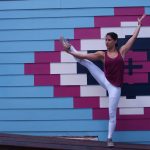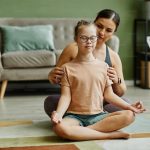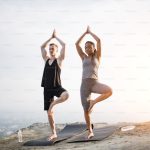We all know that yoga is a great complement for other sports, but can other sports enhance our yoga practice?
Since lockdown began, back in the dawn of time – or just over three months ago – many of us have branched out into other forms of exercise, the most obvious one being more regular walking for our ‘daily exercise’.
Some of us have tried cycling again for the first time in years, others have become Joe Wickes devotees and some have dusted off our running shoes and started jogging again. But will we keep up these extra forms of exercise, and more importantly – should we?
Yoga and Running
Often as yogis, we’re told that yoga is the ONLY exercise we need to do. But that depends on what you call yoga. According to Patanjali’s famous sutras,
Yoga is the stilling of the movement of the mind
and any runner will tell you that the calming effect on the mind is the single best thing about running.
The thing about yoga is that on the whole it is practiced inside. And while we’ve been in lockdown, we have needed to get out of the four walls of our homes and into the great outdoors – or the urban outdoors. I’ve been a yogi and runner for nearly ten years now and I’ve found that the two are excellent co-habiters.
Running increases your heart rate, burns calories, boosts your mood and improves joint health; while yoga opens your hips, lengthens and stretches muscles and tendons, and strengthens the muscles around the knees. While running takes you out of yourself, yoga brings you into yourself.
Should you run and do yoga on the same day? It depends on what your yoga and run will be like. If you’re training for a marathon, then no. If you’re doing a quick 5k, then yes.
Whatever your main focus is, do that activity first. So if you’re doing the running to improve your yoga, then do your yoga practice first, and vice versa.
Yoga and Weight Training
The great Carrie Owerko said in her recent interview that if you want to build muscles, you’re going to have to do some lifting!
From the age of just thirty years old, you will start to lose muscle mass, a process called sarcopenia. This is part of the natural ageing process, but it can be prevented.
Yoga already involves some resistance work – Chaturanga Dandasana is an obvious one for the upper body, but all the Warrior poses, and Utkatasana involves the legs holding your body weight.
If you’re a super-flexible yogi, your problem won’t be making the shapes of the poses but holding them safely. By doing some gentle, regular weight training, you’ll build strength around the joints, making your yoga practice safer. If you have a student that keeps getting injuries due to hyper-mobility, then it might be worth suggesting that they look into adding some weight training into their week.
Yoga and Cycling
I have some very keen cyclists in my yoga classes, and there’s no doubt that yoga helps to stretch out their thighs and open up the hip connectors, as well as the front of the shins and ankles. But can cycling improve our yoga?
Like running, cycling is an aerobic activity that will boost your cardiovascular health. Since lockdown began, sales of bicycles have gone through the roof, as a form of exercise, and also to avoid getting on public transport.
Cycling is also a resistance activity so it builds muscle around the glutes, hamstrings, quads, and calves. For people that work from home, which over the last three months has been nearly everyone, our glutes have had to put up with being sat on – a lot. Cycling helps to strengthen these important muscles, which consequently support the hips and spine.
So for those standing poses that need hamstring and glute strength – think Warrior 1 and Warrior 3, and the tricky Revolved Half Moon pose – cycling could give you an extra boost. But cycling can also cause muscles to become very tight, so be sure to include lots of poses to stretch out the front of the legs in your yoga practice.
Yoga and HIIT
HIIT, or High-Intensity Interval Training, is a hugely popular form of workout. It involves a short burst of intense exercise (as the name suggests) before a rest period, and usually lasts for 15 – 20 minutes. But does this highly energetic form of exercise have anything in common with yoga?
Research shows that HIIT (as compared to moderate forms of exercise) is linked with increasing levels of cardiovascular fitness, boosting aerobic capacity, and the ability of the body to absorb oxygen to make energy. It can also increase muscle mass, which as we know starts to decline from the tender age of 30.
There are already forms of yoga that incorporate this principle: Rocket yoga, power yoga, dynamic vinyasa flow. All these types of yoga will increase your heart rate quickly, and get your sweat up.
If you’ve found that your yoga practice has slipped into a slightly slumberous lockdown rut, then incorporating the principles of HIIT into your practice could be the wake-up call you need. And if you’re a yoga teacher, perhaps your students could do with a high-intensity sun salutation or jumping session to give them an energy boost.
Yoga and Walking
Most of us have been doing a lot of good, old-fashioned walking during the lockdown. Walking is a great way to keep healthier, get outside, and help to reduce polluting the world while we’re at it. Hopefully, this change in habits is something that people will stick to now the lockdown is starting to be eased.
Walking regularly brings all sorts of health benefits, and keeps your bones healthy, and is especially important for those with osteoporosis. Research has also shown that yoga can help increase bone density, so together these forms of exercise can work to keep your bones healthy.
Walking is also a great time to practice mindfulness and to walk off the stresses and strains of a day spent inside at your desk.
Yoga First
While all the above forms of exercise can complement your yoga practice, it’s important to remember what your focus is. Yoga is not just the physical asanas, not just the awareness of the breath, but a path to yourself, and, if you seek it, spiritual enlightenment.
While the body is important, it’s where physical health leads us that is the important factor. Use the methods of yoga in all other forms of exercise that you do, to achieve mental stillness. And make sure that you do all forms of physical exercise (including yoga) in a balanced way – as overdoing any of it will lead to exhaustion and injury.












